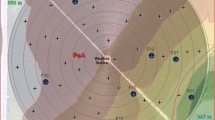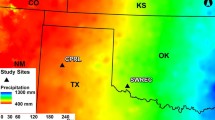Abstract
Cotton produced in Uzbekistan has a low water and fertilizer use efficiency and yield is below its potential. To introduce improved production methods, knowledge is required on how the agro-ecosystem would respond to these alternatives. For this assessment, dynamic simulation models such as the crop-soil simulation model CropSyst are useful tools. CropSyst had never been applied to cotton, so it first was calibrated to the cotton variety Khorezm-127 grown under researcher-managed optimal conditions in the Khorezm region of Uzbekistan in 2005. The model performance was evaluated with a data set obtained in 2004 on two farmer-managed sites. Both data sets comprised in-situ measurements of leaf area index and aboveground biomass. In addition, the 2004 data set included the normalized difference vegetation index derived from satellite imagery of the two cotton fields, which provided estimations of leaf area index with a high temporal resolution. The calibrated optimum mean daily temperature for cotton growth was 25 °C., the specific leaf area 13.0 m2 kg−1, the leaf/stem partition coefficient 3.0, the biomass/transpiration coefficient 8.1 kg m−2 kPa m−2 and the radiation use efficiency 2.0 g MJ−1. Simulations matched 2005 data, achieving a root mean square error between simulated and observed leaf area index and aboveground biomass of 0.36 m2 m−2 and 0.97 Mg ha−1, respectively. The evaluation showed that early cotton growth and leaf area index development could be simulated with sufficient accuracy using CropSyst. However, final aboveground biomass was slightly overestimated by CropSyst, because some unaccounted plant stress at the sites diminished actual aboveground biomass, leading to a root means square error of around 2 Mg ha−1. Some characteristics of cotton, such as the indeterminate growth habit, could not be incorporated in detail in the model. However, these simplifications were compensated by various other advantages of CropSyst, such as the option to simulate crop-rotation or its generic crop growth routine that allows modelling of additional, undocumented crops. The availability of normalized difference vegetation index data with a high temporal and acceptable spatial resolution opened possibilities for a precise, in-expensive and resource-efficient way of model evaluation.
Similar content being viewed by others
References
Allen R.G., Pereira L.S., Raes D., Smith M. (1998) Crop evapotran-spiration — Guidelines for computing crop water requirements — FAO Irrigation and drainage paper 56, Food and Agriculture Organization of the United Nations, Rome.
Bange M.P., Milroy S.P. (2004) Impact of short-term exposure to cold night temperatures on early development of cotton (Gossypium hirsutum L.), Aust. J. Agr. Res. 55, 655–664.
Baret F., Guyot G. (1991) Potentials and limits of vegetation indices for leaf area index and APAR assessment, Remote Sens. Environ. 35, 161–173.
Bechini L., Bocchi S., Maggiore T., Confalonieri R. (2006) Parameterization of a crop growth and development simulation model at sub-model components level. An example for winter wheat (Triticum aestivum L.), Environ. Modell. Softw. 21, 1042–1054.
Blenk S. (2005) Derivation of the leaf area index for cotton and rice based on in-situ measurements and MODIS remote sensing data, University of Würzburg, Unpublished Master Thesis (in German), 154 p.
Bradow J.M., Davidonis G.H. (2000) Review: Quantitation of fiber quality and the cotton production-processing interface: A physiologist’s perspective, J. Cotton Sci. 4, 34–64.
Confalonieri R., Bechini L. (2004) A preliminary evaluation of the simulation model CropSyst for alfalfa, Eur. J. Agron. 21, 223–237.
Confalonieri R., Bocchi S. (2005) Evaluation of CropSyst for simulating the yield of flooded rice in Italy, Eur. J. Agron. 23, 315–326.
Confalonieri R., Gusberti D., Bocchi B., Acutis M. (2006) The CropSyst model to simulate the N balance of rice for alternative management, Agron. Sustain. Dev. 26, 241–249.
Conrad C. (2006) Remote sensing based modeling and hydrological measurements for the assessment of agricultural water use in the Khorezm region (Uzbekistan), University of Wuerzburg, Ph.D. Thesis (in German), 205 p.
Constable G.A. (1976) Temperature effects on the early field development of cotton, Aust. J. Exp. Agr. Anim. Husb. 16, 905–910.
Constable G.A., Rawson H.M. (1980) Effect of leaf position, expansion and age on photosynthesis, transpiration and water use efficiency of cotton, Aust. J. Plant Physiol. 7, 89–100.
Falkenberg N.R., Piccinni G., Cothren J.T., Leskovar D.I., Rush C.M. (2007) Remote sensing of biotic and abiotic stress for irrigation management of cotton, Agr. Water Manage. 87, 23–31.
FAOSTAT (2006) Trade/Crops & livestock primary & processed; Production/Crops Primary; last accessed Nov. 2006.
Ferrer-Alegre F., Stockle C.O. (1999) A model for assessing crop response to salinity, Irrigation Sci. 19, 15–23.
Hartkamp A.D., White J.W., Hoogenboom G. (1999) Interfacing geographic information systems with agronomic modeling: a review, Agron. J. 91, 761–772.
Hearn A.B. (1994) OZCOT: a simulation model for cotton crop management, Agr. Syst. 44, 257–299.
Huete A.R., Didan K., Miura T., Rodriguez E.P., Gao X., Ferreira L.G. (2002) Overview of the radiometric and biophysical performance of the MODIS vegetation indices, Remote Sens. Environ. 83, 195–213.
Ismoilov U.E. (2004) The scientific basis of increasing the soil fertility, (In Russian), Nukus, Bilim, 186 p.
Li H., Lascano R.J., Barnes E.M., Brooker J., Wilson L.T., Bronson K.F., Segarra E. (2001) Multispectral reflectance of cotton related to plant growth soil water and texture, and site elevation, Agron. J. 93, 1327–1337.
Keating B.A., Carberry P.S., Hammer G.L., Probert M.E., Robertson M.J., Holzworth D., Huth N.I., Hargreaves J.N.G., Meinke H., Hochman Z., McLean G., Verburg K., Snow V., Dimes J.P., Silburn M., Wang E., Brown S., Bristow K.L., Asseng S., Chapman S., McCown R.L., Freebairn D.M., Smith C.J. (2003) An overview of APSIM, a model designed for farming systems simulation, Eur. J. Agron. 18, 267–288.
Ko J., Maas S.J., Lascano R.J., Wanjura D. (2005) Modification of the GRAMI model for cotton, Agron. J. 97, 1374–1379.
Kremer C., Stockle CO., Kemanian A.R., Howell T. (2008) A reference canopy transpiration and photosynthesis model for the evaluation of simple models of crop productivity, accepted for publication by Agronomy Journal.
Maas S.J. (1992) GRAMI: A crop growth model that can use remotely sensed information, ARS-91 USDA, Washington, DC.
Marani A. (2006) Cotton2K Model version 4.0., Internet Publikation: http://departments.agri.huji.ac.il/plantscience/cotton/Cotton2KModelDoc.htm.
Martius C., Lamers J.P.A., Wehrheim P., Schoeller-Schletter A., Eshchanov R., Tupitsa A., Khamzina A., Akramkhanov A., Vlek P.L.G. (2004) Developing sustainable land and water management for the Aral Sea Basin through an interdisciplinary research, in: Seng V., Craswell E., Fukai S. (Eds.), Water in agriculture, ACIAR Proceedings No. 116, Canberra, pp. 45–60.
Milroy S.P., Bange M.P. (2003) Nitrogen and light response of cotton photosynthesis and implications for crop growth, Crop Sci. 43, 904–913.
Moriondo M., Maselli F., Bindi M. (2007) A simple model of regional wheat yield based on NDVI data, Eur. J. Agron. 26, 266–274.
Pannkuk C.D., Stockle C.O., Papendiek R.I. (1998) Evaluating CropSyst simulations of wheat management in a wheat-fallow region of the US Pacific Northwest, Agr. Syst. 57, 121–134.
Peng S., Krieg D.R. (1991) Single leaf and canopy photosynthesis response to plant age in cotton. Agron. J. 83, 704–708.
Reddy V.R., Acock B., Baker D.N., Acock M. (1989) Seasonal leaf area-leaf weight relationships in the cotton canopy, Agron. J. 81, 1–4.
Reddy V.R., Baker D.N., Hodges H.F. (1991) Temperature effects on cotton canopy growth, photosynthesis, and respiration, Agron. J. 83, 699–704.
Rosenthal W.D., Gerik T.J. (1991) Radiation use efficiency among cotton cultivars, Agron. J. 83, 655–658.
Scheer C., Wassmann R., Kienzler K., Ibragimov N., Eshanov R. (2008) Nitrous oxide emissions from fertilized, irrigated cotton (Gossypium hirsutum L.) in the Aral Sea Basin, Uzbekistan: Influence of nitrogen applications and irrigation practices, Soil Biol. Biochem. 40, 290–301.
Sommer R., Wall P.C., Govaerts B. (2007) Model-based assessment of maize cropping under conventional and conservation agriculture in highland Mexico, Soil Till. Res. 94, 83–100.
Stockle C.O., Donatelli M., Nelson R. (2003) CropSyst, a cropping systems simulation model, Eur. J. Agron. 18, 289–307.
Tanner C.B., Sinclair T.R. (1983) Efficient water use crop production: Research or Re—search? in: Taylor H.M., Jordan W.R., Sinclair T.R. (Eds.), Limitations to Efficient Water Use in Crop Production, pp. 1–27, ASA-CSSA-SSSA, Madison, 538 p.
Vermote E.F., El Saleous N.Z., Justice C.O. (2002) Atmospheric correction of MODIS data in the visible to middle infrared: first results, Remote Sens. Environ. 83, 97–111.
Zhao D., Li J., Qi J. (2004) Hyperspectral characteristic analysis of a developing cotton canopy under different nitrogen treatments, Agronomie 24, 463–471.
Author information
Authors and Affiliations
Corresponding author
About this article
Cite this article
Sommer, R., Kienzler, K., Conrad, C. et al. Evaluation of the CropSyst model for simulating the potential yield of cotton. Agron. Sustain. Dev. 28, 345–354 (2008). https://doi.org/10.1051/agro:2008008
Accepted:
Issue Date:
DOI: https://doi.org/10.1051/agro:2008008




